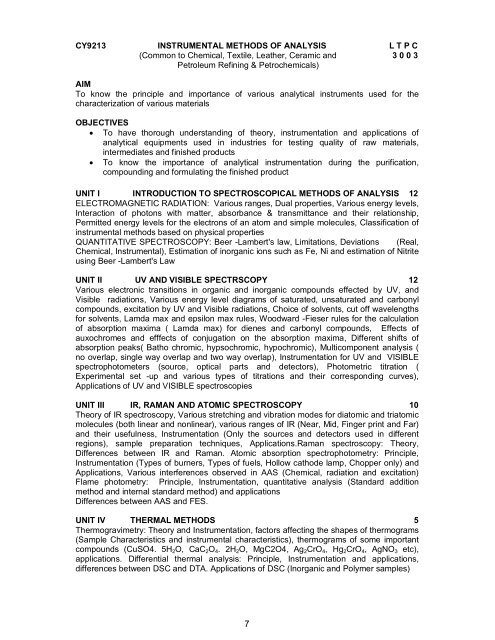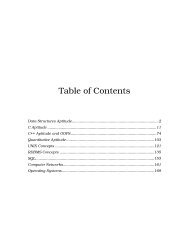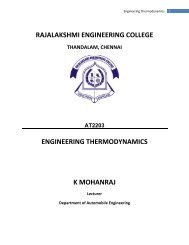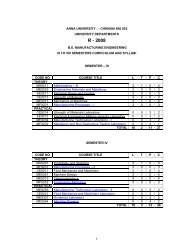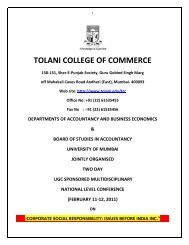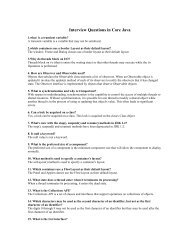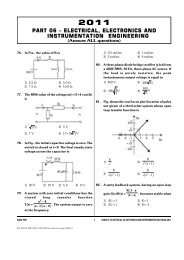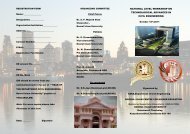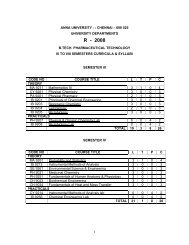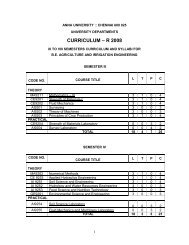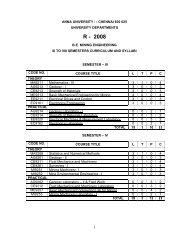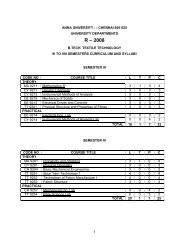b.tech. ceramic technology - Technicalsymposium
b.tech. ceramic technology - Technicalsymposium
b.tech. ceramic technology - Technicalsymposium
Create successful ePaper yourself
Turn your PDF publications into a flip-book with our unique Google optimized e-Paper software.
CY9213 INSTRUMENTAL METHODS OF ANALYSIS L T P C(Common to Chemical, Textile, Leather, Ceramic and 3 0 0 3Petroleum Refining & Petrochemicals)AIMTo know the principle and importance of various analytical instruments used for thecharacterization of various materialsOBJECTIVES To have thorough understanding of theory, instrumentation and applications ofanalytical equipments used in industries for testing quality of raw materials,intermediates and finished products To know the importance of analytical instrumentation during the purification,compounding and formulating the finished productUNIT I INTRODUCTION TO SPECTROSCOPICAL METHODS OF ANALYSIS 12ELECTROMAGNETIC RADIATION: Various ranges, Dual properties, Various energy levels,Interaction of photons with matter, absorbance & transmittance and their relationship,Permitted energy levels for the electrons of an atom and simple molecules, Classification ofinstrumental methods based on physical propertiesQUANTITATIVE SPECTROSCOPY: Beer -Lambert's law, Limitations, Deviations (Real,Chemical, Instrumental), Estimation of inorganic ions such as Fe, Ni and estimation of Nitriteusing Beer -Lambert's LawUNIT II UV AND VISIBLE SPECTRSCOPY 12Various electronic transitions in organic and inorganic compounds effected by UV, andVisible radiations, Various energy level diagrams of saturated, unsaturated and carbonylcompounds, excitation by UV and Visible radiations, Choice of solvents, cut off wavelengthsfor solvents, Lamda max and epsilon max rules, Woodward -Fieser rules for the calculationof absorption maxima ( Lamda max) for dienes and carbonyl compounds, Effects ofauxochromes and efffects of conjugation on the absorption maxima, Different shifts ofabsorption peaks( Batho chromic, hypsochromic, hypochromic), Multicomponent analysis (no overlap, single way overlap and two way overlap), Instrumentation for UV and VISIBLEspectrophotometers (source, optical parts and detectors), Photometric titration (Experimental set -up and various types of titrations and their corresponding curves),Applications of UV and VISIBLE spectroscopiesUNIT III IR, RAMAN AND ATOMIC SPECTROSCOPY 10Theory of IR spectroscopy, Various stretching and vibration modes for diatomic and triatomicmolecules (both linear and nonlinear), various ranges of IR (Near, Mid, Finger print and Far)and their usefulness, Instrumentation (Only the sources and detectors used in differentregions), sample preparation <strong>tech</strong>niques, Applications.Raman spectroscopy: Theory,Differences between IR and Raman. Atomic absorption spectrophotometry: Principle,Instrumentation (Types of burners, Types of fuels, Hollow cathode lamp, Chopper only) andApplications, Various interferences observed in AAS (Chemical, radiation and excitation)Flame photometry: Principle, Instrumentation, quantitative analysis (Standard additionmethod and internal standard method) and applicationsDifferences between AAS and FES.UNIT IV THERMAL METHODS 5Thermogravimetry: Theory and Instrumentation, factors affecting the shapes of thermograms(Sample Characteristics and instrumental characteristics), thermograms of some importantcompounds (CuSO4. 5H 2 O, CaC 2 O 4 . 2H 2 O, MgC2O4, Ag 2 CrO 4 , Hg 2 CrO 4 , AgNO 3 etc),applications. Differential thermal analysis: Principle, Instrumentation and applications,differences between DSC and DTA. Applications of DSC (Inorganic and Polymer samples)7


